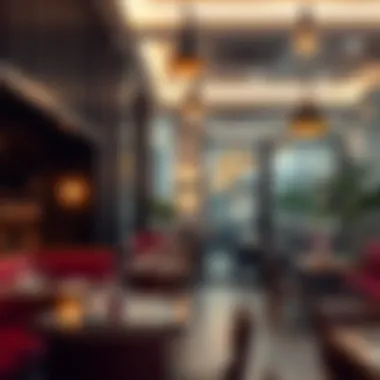Exploring Dining Options in Dubai's Downtown City Centre


Intro
Dubai's Downtown City Centre (DCC) stands as a vibrant confluence of luxury living and culinary brilliance. With its bustling streets lined with restaurants, cafes, and bars, the DCC presents a dynamic dining experience that attracts both locals and tourists alike. This article provides a detailed examination of the diverse offerings within this area, and more importantly, we will dissect how the gastronomic landscape influences property values and neighborhood dynamics.
As you wander the elegantly designed avenues, it becomes clear that dining is not merely about sustenance here; it's about creating memorable experiences. The restaurants reflect the city’s cultural diversity and the evolving preferences of its inhabitants, mirroring broader trends in both the culinary and real estate markets. Whether you’re an investor looking to understand the impact of these dining experiences on property valuation, a broker aiming to entice clients with lifestyle offerings, or simply a curious diner, the insights provided here will illuminate the intricate relationship between dining and real estate in Dubai's ever-evolving downtown landscape.
In the following sections, we will delve into market trends, highlight investment opportunities, and provide insights into why the culinary sector plays a pivotal role in shaping the desirability of living in proximity to these dining havens.
Overview of Downtown City Centre
The Downtown City Centre (DCC) holds a pivotal role in the fabric of Dubai, representing a melding of symbolic landmarks, vibrant streets, and a culinary scene that is as diverse as its populace. As we delve into the various sections of DCC, it becomes evident that understanding its significance is crucial for anyone interested in the dynamics of urban life and investment opportunities within this area. The interplay between the neighborhood’s geography, history, and dining options creates a complex tapestry that attracts not just tourists but also residents, investors, and food enthusiasts alike.
Geographical Significance
DCC is strategically located in the heart of Dubai, making it a nucleus around which much of the city’s energy circulates. The geographical placement allows for easy access to major attractions such as the Burj Khalifa and the Dubai Mall. This central spot becomes a hive of activity where locals and visitors move about, fueled by the accessibility of multiple transport links, including the Dubai Metro and numerous bus routes. The interplay between the skyline and the surrounding greenspaces, like the Burj Park, enriches the aesthetic appeal of the area, which further enhances its desirability as a dining and living destination.
Moreover, the proximity to important business districts encourages a flow of expatriates and entrepreneurs seeking culinary experiences that reflect global trends while still resonating with local flavors. In other words, geography, in this case, is not just physical space; it’s about the cultural and economic vibrancy that this setting supports.
Historical Context
To grasp the current allure of DCC, one must peer into its past. Dubai has transformed dramatically over the past several decades, evolving from a modest trading post to a bustling metropolitan center renowned for luxury and innovation. This transformation has roots in the oil boom of the 1960s, but the real pivot came when Dubai decided to diversify its economy. With an eye towards tourism and hospitality, the city began to invest heavily in development, turning DCC into a premier urban landscape.
The historical significance translates into dining as well. Many restaurants here pay homage to the rich tapestry of cultures that have woven into Dubai’s history. From traditional Emirati cuisine to critically acclaimed international offerings, the evolution of culinary experiences echoes the broader narrative of progress and globalization in the region. The past shapes the present, giving diners not just a meal but a taste of history with every bite they take.
"In DCC, gastronomy captures the essence of Dubai’s evolution—where every dish tells a story rooted in tradition yet inspired by contemporary innovation."
Understanding the historical context allows discerning diners and potential investors to appreciate what DCC truly represents. It's not merely a dining district but a symbol of a city that embraces both its heritage and its future.
Culinary Landscape of
The culinary landscape in Dubai's Downtown City Centre (DCC) is nothing short of a vibrant tapestry woven from both traditional and modern influences. In an era where dining has transcended beyond mere sustenance, it is crucial for investors, brokers, expatriates, and researchers to grasp the significance of this landscape. This section delves deep into the elements that define the dining experiences in DCC, showcasing how these factors contribute to not just gastronomic satisfaction but also to the economic and social fabric of the area.
Types of Dining Experiences
DCC offers a kaleidoscope of dining experiences, each uniquely tailored to satisfy diverse palates. At the higher end of the spectrum are fine dining establishments, where culinary artistry melds with exceptional service. For instance, places like At.mosphere, located within the Burj Khalifa, provide a luxurious experience with stunning panoramic views.
On the other end, casual dining venues serve up comfort food with charm. Restaurants like The Cheesecake Factory offer a more relaxed atmosphere, where families can indulge without breaking the bank. Furthermore, the emergence of food trucks and pop-up eateries creates a casual and adventurous dining culture. This variety ensures there is something for everyone, making dining in DCC not just a meal, but an experience.
- Fine Dining: High-end, expert cuisine.
- Casual Dining: Relaxed, family-friendly choices.
- Street Food and Pop-Ups: Affordable and trendy options.
Cultural Influences on Cuisine
Cultural diversity is one of DCC’s key assets, and its culinary scene reflects this melting pot. With residents and visitors from all corners of the globe, the restaurants have adapted traditional recipes, leading to innovative dishes that tell a story of their origins. For instance, the presence of Indian cuisine notably enhances DCC's culinary fold. Restaurants like Indya by Vineet offer an exciting twist, blending Indian spices with local flavors to create dishes that resonate with both locals and visitors alike.
"In DCC, every bite is a reflection of the global village that it represents—cooking brings people together across languages and borders."
Adapting to global influences is also apparent in the popularity of fusion cuisine. Restaurants integrating Asian and Middle Eastern flavors are reshaping what diners consider traditional. These culinary experiments enhance the food scene, pushing boundaries and creating conversations around flavors.
Emerging Trends in Dining
As dining habits evolve, DCC stands at the forefront of innovative food trends. With health-consciousness becoming a priority, many restaurants are shifting towards offering organic and locally sourced ingredients. This movement is observed in establishments that emphasize sustainability, aligning with the broader global trend where consumers seek transparency about their food sources.
Moreover, technological advancements have paved the way for a surge in online food delivery services—making it easier than ever for residents and businesses alike to enjoy diverse cuisines without stepping foot outside. From apps like Deliveroo to Talabat, convenience has become a significant factor.


- Sustainable Practices: Increasingly important to consumers.
- Technology Integration: Food delivery and online reservations enhance accessibility.
- Plant-Based Menus: A growing consideration for health-conscious diners.
In summary, the culinary landscape of DCC is more than just a collection of dining venues. It is a reflection of the area's economic viability, cultural inclusivity, and the adaptability of its food scene. For those who leverage this knowledge, the intersections of dining offerings with real estate and lifestyle opportunities become clearer, ultimately influencing where one chooses to invest or live.
Signature Restaurants in
The dining scene in Downtown City Centre (DCC) is not just about food; it’s a hallmark of cultural influence, economic growth, and residential appeal. Signature restaurants represent the pinnacle of this vibrant ecosystem, marrying not only exquisite culinary offerings but also unforgettable experiences that attract various demographics. When considering investments or lifestyle choices in DCC, understanding the signature dining establishments is crucial. These restaurants often serve as landmarks, shaping neighborhood identity and serving as focal points for community interaction.
Fine Dining Establishments
Fine dining in DCC takes on a meaning that extends beyond just lavishness; it’s about artistry, skill, and an exceptional attention to detail. Venues such as At.mosphere and NOBU, located in luxurious settings, boast not only impeccable cuisine but also stunning views that heighten the overall dining experience. These establishments cater to a clientele that often seeks an exclusive atmosphere, making reservations difficult to come by and enhancing the allure of their offerings.
When dining at such restaurants, diners can expect a meticulously curated menu that reflects both local and international flavors. Plating is as much an art form as the cooking itself. The ambiance, characterized by soft lighting and elegant furnishings, plays a significant role in the dining experience, encouraging patrons to linger and enjoy every moment.
Often referred to as 'culinary adventures,' fine dining experiences in DCC are not just meals, but explorations of taste and culture, deeply tied to how residential properties value shifts around these culinary hotspots.
Casual Dining Options
In contrast to the formalities of fine dining, casual dining options in DCC offer a relaxed atmosphere without compromising on quality. Restaurants like Folly by Nick & Scott and TOMO command a loyal following due to their approachable menus and inviting environments. These spots cater to families, busy professionals, and friends looking for a casual meet-up.
Highlights include a diverse range of international cuisines that are not pretentious, but still delightfully curated. The emphasis here lies in comfort food without losing the inventive twists that characterize Dubai's global dining scene. Casual dining favorites typically feature friendly service and a menu that caters to a broad audience, providing everything from hearty burgers to fresh sushi, ensuring that everyone leaves with something satisfying.
Cafés and Bistro Culture
The café and bistro culture in DCC flourishes, creating vital spaces for social engagement and work-life balance. Places like Cafe Society and The Sum of Us are not only enclaves for coffee lovers, but also represent a lifestyle choice for many expatriates and locals alike. Engaging with these spaces allows residents to blend social interactions with their day-to-day tasks, often turning grocery shopping or a coffee run into an enjoyable rendezvous.
These establishments often prioritize locally sourced ingredients, which resonate with the sustainability trend permeating the culinary world today. A well-crafted cup of coffee or a hearty breakfast can serve as a grounding ritual that nurtures the community spirit among residents.
International and Fusion Cuisine
The international and fusion cuisine segment in DCC is a mesmerizing tapestry woven from diverse culinary traditions, reflecting the multicultural landscape of Dubai itself. Restaurants such as Zuma and Coya offer not just food, but narratives through their culinary creations. The blending of heritage flavors and innovative techniques leads to dishes that stand apart from conventional options, promoting a sense of discovery among diners.
This inclination toward fusion cuisine is particularly appealing to those in DCC who appreciate the cross-cultural exchanges that dining can bring. Dishes often incorporate local spices or ingredients, yet present them in ways that harken from far-off lands, presenting a flavorful experience that resonates with a modern, exploratory palate.
DCC's signature restaurants are not merely venues for eating; they mirror the evolution of community experiences and property value correlations in the ever-changing city landscape.
In summary, the diversity among signature restaurants in DCC influences more than just personal choices regarding dining. They are critical metrics for property value, with their offerings shaping the very essence of urban living in Dubai.
The Economic Impact of Restaurants on
The bustling food scene in Downtown City Centre (DCC) extends beyond mere flavor; it plays a pivotal role in the economic framework of the area. Understanding the economic impact of restaurants provides key insights into how these culinary establishments stimulate growth, influence property markets, and generate jobs. With budgets tightening and consumer preferences evolving, the importance of grasping the intersection between dining and economic factors has never been more pronounced.
Contribution to Local Economy
Restaurants not only serve meals; they are, in many ways, the backbone of the local economy. DCC’s diverse culinary establishments contribute significantly to revenue generation. These restaurants attract both residents and tourists, driving foot traffic that leads to spending not only on food but also on other local services, like retail and entertainment.
- Local Lakes: A thriving dining scene often leads to increased sales tax revenue for local governments. This revenue can then be reallocated to services such as public safety and infrastructure improvements.
- Business Ecosystem: When restaurants thrive, they often influence the success of adjacent businesses. Coffee shops, bakeries, and shopfronts in DCC often see greater patronage as a result of nearby dining options.
As a result, restaurants are essential in creating a tightly knit economic ecosystem; they draw diverse crowds and connect various sectors of the community.
Real Estate Value Correlation
The nexus between restaurants and real estate in DCC is clear. Studies have shown that areas with a rich culinary tapestry tend to have higher property values. This correlation speaks volumes about the desirability of a neighborhood.


- Attractiveness of Location: Buyers often prioritize proximity to remarkable dining experiences, finding value in the convenience of having high-quality establishments within walking distance.
- Market Trends: Invest in properties near restaurants, and they can sharply increase in value, driven by demand from buyers and renters looking for vibrant neighborhoods.
Moreover, it’s not just about the immediate effect. Over time, as more restaurants establish themselves, they contribute to a stable market dynamic, where increased property values become the norm.
Job Creation and Employment
One of the most substantial impacts of restaurants in DCC is on employment. The food industry is a robust job creator, offering a variety of roles that cater to different skillsets.
- Diverse Opportunities: From waitstaff to chefs and management positions, restaurants provide a wide range of job opportunities that can help reduce unemployment in the area. The skills learned in the restaurant business can often be transferable to other sectors as well, enhancing long-term career prospects for employees.
- Support Roles: Beyond direct employment, restaurants also create jobs in supporting industries. Suppliers, delivery services, and maintenance providers all see increased demand as the restaurant sector flourishes.
As the job market stabilizes and grows, it not only helps residents of DCC but also fosters a sense of community and stability, making the neighborhood an attractive place for both new businesses and residents.
"The convergence of thriving restaurants, flourishing property values, and vibrant employment opportunities creates an economic trifecta that benefits all stakeholders in DCC."
In summation, the economic footprint that restaurants leave on DCC is substantial. They contribute to local revenue, influence real estate dynamics positively, and create a multitude of jobs. Understanding these impacts is crucial for investors and buyers alike, as they navigate the ever-evolving landscape of Downtown City Centre.
Choosing the Right Restaurant
Selecting the right restaurant is far more than simply picking a place to eat; it is an experience woven into the fabric of activities and preferences for diners. It's about finding a setting that aligns not just with your palate, but also with the desired ambiance, social context, and even the nutritional values one holds dear. In the vibrant tapestry of Downtown City Centre, where culinary offerings abound, this selection process becomes even more critical, given the high stakes of dining choices that affect social reputations and investment possibilities.
The elements influencing a good restaurant choice can range from food quality to location, encompassing budget considerations and dietary restrictions. These factors combine to create a deeply personal experience, making one’s meal memorable or mundane. Each visit can leave a lasting impression, shape social identity, and influence potential investments in the property market.
Factors Influencing Restaurant Selection
When it comes down to choosing a restaurant, various significant factors come into play. Here are prominent ones:
- Cuisine Type: The availability of various cuisines such as Middle Eastern, Asian, or European can sway decision-making. Each cuisine brings its unique flavors and cooking methods, ultimately enhancing the overall dining experience.
- Ambiance and Atmosphere: The interior design, lighting, and music contribute enormously to how one feels during a meal. A cozy bistro might be perfect for a date, while a bustling café could be ideal for a casual catch-up with friends.
- Accessibility and Location: In a city like Dubai, where the metropolitan buzz is palpable, the convenience of location can make or break a restaurant’s appeal. Being close to major attractions or easily reachable by public transport adds to the allure.
- Price Range: Budget considerations vary widely among individuals or groups, and understanding the pricing before landing at a specific restaurant is crucial. High-end establishments may serve exquisite dishes but might not suit every occasion.
- Dietary Preferences: With the rising health consciousness, many diners are mindful of their nutritional intake. Vegan options, gluten-free menus, or organic ingredients greatly influence the choice of restaurant.
The Role of Restaurant Reviews
In today’s digital age, restaurant reviews play a pivotal role in guiding potential diners. They are often the first stop for those contemplating a new dining adventure. Reviews reflect a blend of subjective experiences and generalized expectations, painting a holistic picture of what the restaurant has to offer.
Opinions from previous patrons can serve as a guiding light, highlighting strengths and weaknesses. Reviews on platforms like Yelp or TripAdvisor offer insights into:
- Food Quality: Descriptions and images often help future customers gauge the flavors and presentation.
- Service Quality: A theme often running through many reviews is service—whether staff were attentive or indifferent can be a make-or-break factor.
- Overall Value: Comments about whether a restaurant is worth its price can be crucial in influencing choices and ensuring satisfaction.
In particular, online platforms allow for a wealth of voices and perspectives, echoing the collective experience of diners and shaping one’s expectations.
"In a world overflowing with choices, shared experiences guide our paths, illuminating the path to culinary delight or disappointment."
The impact of reviews cannot be understated; they are a vital consideration for savvy diners, investors, or anyone navigating the culinary landscape of the downtown scene. Overall, understanding these factors equips individuals with the knowledge to discover their perfect dining match in the bustling heart of Downtown City Centre.
Future Prospects for Dining
As we peer into the future of dining in Downtown City Centre (DCC), it’s like gazing into a crystal ball filled with culinary opportunities. The growth of the dining sector here is not just significant; it acts as a barometer for broader economic trends. With cutting-edge concepts emerging and a growing appetite for unique dining experiences, DCC stands at the precipice of an exciting gastronomic evolution.
Understanding future prospects involves examining various facets: consumer demand, technological advancements, and market adaptation. Investors, brokers, and diners alike should keep a keen eye on the shifting sands of the culinary landscape. Recognizing these changes offers valuable insights into potential investments and developments in the surrounding real estate market.
"The future of dining is not just about the food; it’s about creating experiences that resonate within the community."
Anticipated Trends in Cuisine
Dining trends evolve as swiftly as the seasons change, particularly in a cosmopolitan hub like DCC. Futuristic cuisine trends indicate a shift towards sustainability, plant-based options, and hyper-local sourcing. From vegan establishments to innovative dishes that incorporate local ingredients, diners are increasingly concerned about the origins of their food and the environmental impacts of their choices.


- Plant-Based Revolution: More restaurants are whipping up dishes that cater to health-conscious diners. Meat alternatives are no longer just an afterthought; they are the centerpiece of many menus.
- Experiential Dining: Restaurants offering immersive experiences—think cooking classes or themed dinners—are on the rise. Patrons value more than just a meal; they crave connections and experiences that engage all senses.
- Technology Integration: Advances such as digital menus via apps or augmented reality in dining spaces are becoming common. These innovations not only streamline operations but also elevate customer engagement. Customizing a dish with a few taps on a screen enhances personal experience while dining.
The increase in culinary creativity is compounded by a growing interest in global flavors, with fusion cuisine becoming the norm. This blend of influences will surely continue to shape the dining scene in DCC moving forward.
Potential for New Dining Establishments
The potential for new dining establishments in DCC holds promise for both culinary adventurers and savvy investors. As urban demographics shift, so too does the demand for diverse culinary experiences. Each neighborhood within DCC has its own character, leading to opportunities tailored to specific tastes and preferences.
- Niche Markets: Specialty eateries focusing on particular cuisines or dietary preferences can find a warm welcome. Whether it’s gluten-free bakeries or artisanal cocktail bars, carved-out niches often flourish in a vibrant urban landscape.
- Community-Centric Spaces: Restaurants that prioritize community involvement—hosting local events, showcasing local artists, or even engaging in charitable activities—can create loyal customer bases. People tend to prefer places that resonate with their values.
- Collaborative Concepts: There is increasing interest in restaurants that partner with local farms or producers. These ventures not only enhance the quality of the food but also contribute to the local economy and sustainability.
Sustainability in Restaurants
Sustainability in dining establishments carries a lot of weight, especially in a cosmopolitan hub like Downtown City Centre (DCC). The growing awareness of environmental issues makes restaurants reconsider their operational practices and impact on the environment. Not only do these practices appeal to a more conscious consumer base, but they also offer long-term benefits that can enhance a restaurant's brand and profitability. Given that DCC attracts both locals and tourists alike, it's crucial for restaurants here to embody a sustainable ethos that resonates with their diverse clientele.
Eco-Friendly Practices
In DCC, many restaurants have recognized the need for eco-friendly practices as part of their operational framework. This includes a variety of approaches, such as:
- Energy-efficient appliances: Many establishments invest in modern kitchen equipment that uses less energy. This not only reduces their carbon footprint but also lowers operating costs.
- Waste management systems: Composting and recycling programs are increasingly implemented to minimize waste sent to landfills. By sorting out compostable materials, these restaurants can significantly reduce their impact on the environment.
- Digital menus: Switching to digital instead of printed menus helps to cut down paper usage, and many diners find this option more convenient.
Restaurant owners have noted that showcasing eco-friendly practices can draw in patrons who are eager to support sustainable businesses. This serves not just as a marketing tool, but also creates a loyal customer base that values environmental responsibility.
Overall, being eco-conscious not only helps the environment but can also put restaurants ahead in a highly competitive market.
Local Sourcing of Ingredients
Local sourcing of ingredients is another critical aspect of sustainability that many DCC restaurants take seriously. The advantages are manifold:
- Freshness: Ingredients sourced from nearby farms tend to be fresher and more flavorful than those that have traveled long distances. This enhances the dining experience and is a key selling point for many chefs.
- Support for local economy: By buying from local farmers and suppliers, restaurants help keep the local economy vibrant. This practice strengthens community ties and fosters a sense of solidarity among locals.
- Reduced carbon footprint: Transporting food over long distances contributes to greenhouse gas emissions. By sourcing ingredients locally, restaurants can significantly lessen their environmental impact.
Investing in local sourcing can be a win-win: for the environment, the community, and the restaurants themselves. Not only does it allow them to offer unique, fresh dishes, but it also aligns with the growing consumer demand for sustainability in dining.
In summary, the sustainability efforts seen in DCC restaurants not only enhance the vibrancy of the dining options available but also reflect a collective commitment to nurturing the urban ecosystem. As diners continue to demand more sustainable options, it becomes paramount for these restaurants to keep innovating in their practices.
Dining and Lifestyle in
Exploring the relationship between dining and lifestyle in Dubai's Downtown City Centre (DCC) offers a fascinating glimpse into the fabric of urban living. As we peel back the layers, it becomes evident that restaurants do not merely serve food—they are, in many ways, the heart and soul of community interaction. The culinary scene informs and enhances the lifestyle of residents and visitors alike, creating an environment that’s both vibrant and inviting.
Integration of Dining with Urban Living
The integration of dining into urban life in DCC is fundamental. Restaurants are more than just places to eat; they act as social hubs, creating opportunities for connection, collaboration, and culture. For investors and potential buyers, understanding this dynamic is crucial. A thriving dining scene can elevate property values, making neighborhoods more attractive to both residents and business owners.
In DCC, walkability is a key factor. Restaurants are strategically located to foster easy access, creating a solid relationship between food, lifestyle, and urban spaces. Whether it’s enjoying a quick meal during a lunch break or hosting dinner parties with friends, these establishments cater to an array of lifestyle preferences. Street-side cafés, refined dining rooms, and cozy bistros offer diverse experiences that meet the needs of everyone—from busy professionals to leisurely families.
Some salient aspects to consider include:
- Accessibility: Restaurants enhance urban living through their strategic placements, ensuring that residents can enjoy meals without needing to travel far.
- Cultural Events: Many establishments host events that celebrate local culture, further weaving dining into the lifestyle fabric of DCC.
- Diversity: A wide range of culinary options encourages diverse lifestyles, appealing to different tastes, budgets, and social needs.
Social and Community Aspects
The restaurants in DCC play a pivotal role in the social structure of the area. They promote community and belonging, helping to forge social ties among residents. Eating together is one of the oldest communal activities, and in DCC, this tradition is kept alive through various dining experiences.
"The right restaurant can transform a meal into a gathering, a private moment into a shared memory."
Community-focused restaurants often feature local art, host cultural events, or collaborate with nearby businesses to create a sense of unity. Such initiatives not only enhance customer experience but help build a supportive network among local businesses, fostering economic growth and sustainability.
Key points illustrating the community aspect include:
- Collaborative Events: Activities like pop-up markets and food festivals in the DCC area bring together various restaurants and cuisines, creating a festive atmosphere that draws both locals and tourists.
- Networking Opportunities: Many restaurants double as event spaces for networking events, art showcases, and social meet-ups, facilitating connections that go beyond mere culinary experiences.
- Engagement with Local Issues: Numerous dining establishments engage in local initiatives, promoting sustainability, local charities, and community service, thus deepening their ties to the neighborhood.
In short, as one delves deeper into the dining and lifestyle interplay in DCC, it’s clear that restaurants do not exist in isolation. They are inherently connected to daily life, shaping the social experience, influencing property values, and reinforcing the community’s identity—a true testament to the power of a well-curated culinary scene.







